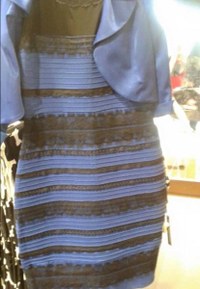“This never would have happened with a red dress”
Psychologists from Gießen and Bradford comment on the confusion about the colour of #TheDress
No. 79 • May 14th, 2015
A few months ago, a snapshot of a lace-decorated dress puzzled social network users worldwide. Why do some people argue that they see a blue and black dress while others describe the same dress as white and gold? Perceptual psychologists from the Universities of Giessen and Bradford examined the question in more detail by conducting an experiment. One of the outcomes: “This would not have happened with a red dress”, says Prof. Dr. Karl Gegenfurtner, department of psychology at Justus Liebig University Giessen (JLU). The reason behind the confusion about the colours of the dress is the photograph’s overall bluish and yellowish colouring. The research results have recently been published in the journal “Current Biology”.
The team, including Prof. Marina Bloj from the University of Bradford, discovered that all test subjects basically perceived similar colour shades, only varying in lightness. The perception of colours ranges from a very light blue (almost white) to bright mid blue, from yellow and gold to an intense and dark brown (almost black). And yet, the transitions are fluid: Neither the people who view the dress as white and gold nor those perceiving it as black and blue constitute a homogenous group. However, the perceived colours have something in common: They all are part of the so-called daylight locus; depending on the position of the sun during the course of the day, daylight tends to be rather bluish (at noon) or rather yellowish (in the morning and in the evening).
Usually, people are able to unconsciously filter the effect of bluish or yellowish light with the result that everyone perceives the same colours. To do so, we require reference points, thus colours, which are located outside the daylight locus. However, green or red features are completely missing in the case of #TheDress, as it was called in social networks. Therefore, the photograph does not provide relevant information on the scene’s luminance levels. “The perceived hue in one of the groups of observers is related to the fact that a white dress was exposed to cool bluish light”, explains Prof. Gegenfurtner. “Just as well it could be a blue dress which was overexposed by warm light.” The fact that it is indeed a blue/black dress, which is well known by now, is regarded as a matter of minor importance. The observers do not consciously decide for one version or the other.
Various studies have proven that people have difficulties perceiving colours along the daylight locus correctly. Test subjects are for instance rarely able to set a completely neutral grey on the screen without tending to a slightly bluish or yellowish tinge. Deviations concerning red or green tendencies on the contrary hardly ever occur, which, in turn, explains why a red and green colouring of the dress on a screen by the team of authors has not led to any perceptual disagreements among the test subjects.
- Article
Karl R. Gegenfurtner, Marina Bloj and Matteo Toscani: The many colours of ‘the dress’, Current Biology 25, R1–R3, June 15, 2015
DOI: 10.1016/j.cub.2015.04.043
http://dx.doi.org/10.1016/j.cub.2015.04.043
- Contact
Prof. Dr. Karl Gegenfurtner, Justus-Liebig-Universität Giessen
Abteilung Allgemeine Psychologie
Phone: +49 (0) 641 99-26100
Prof. Marina Bloj, University of Bradford
Bradford School of Optometry and Vision Sciences
Phone: +44 (0) 1274 236258
Pressestelle der Justus-Liebig-Universität Gießen, Telefon 0641 99-12041
